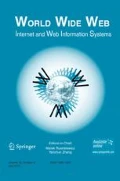Abstract
We are living in a world of various kinds of social information networks with small-world and scale-free characteristics. It is still an intriguing problem for researchers to explain how and why so many obviously different networks emerge and share common intrinsic characteristics such as short diameter, higher cluster and power-law degree distribution. Most previous works studied the topology formation and information navigation of complex networks in separated models. In this paper, we propose a metric based range intersection model to explore the topology evolution and information navigation in a synthetic way. We model the network as a set of nodes in a distance metric space where each node has an ID and a range of neighbor information around its ID in the metric space. The range of a node can be seen as the local knowledge or information that the node has around its position in the metric space. The topology is formed by setting up a link between two nodes that have intersected ranges. Information navigation over the network is modeled as a greedy routing process using neighbor links and the distance metric. Different from previous models, we do not assume that nodes join the network one by one and set up link according to the degree distribution of existing nodes or distances between nodes. Range of node is the key factor determining the topology and navigation properties of a network. Moreover, as the ranges of nodes grow, the network evolves from a set of totally isolated nodes to a connected network. Thus, we can easily model the network evolutions in terms of the network size and the individual node information range using the range intersection model. A set of experiments shows that networks constructed using the range intersection model have the scale-free degree distribution, high cluster, short diameter, and high navigability properties that are owned by the real networks.
Similar content being viewed by others
References
Adamic, L.A., Lukose, R.M., Puniyani, A.R., Huberman, B.A.: Search in power-law networks. Phys Rev E 64(4), 046135 (2001)
Albert, R., Barabasi, A.L.: Statistical mechanics of complex networks. Rev Mod Phys 74(1), 47 (2002)
Albert, R., Jeong, H., Barabasi, A.L.: Diameter of the World Wide Web. Nature 401, 130–131 (1999)
Angeles, M., Krioukov, D., Boguna, M.: Self-similarity of complex networks and hidden metric spaces. Phys Rev Lett 100(7), 078701 (2008)
Barabasi, A.L., Albert, R.: Emergence of scaling in random networks. Science 286(5439), 509–512 (1999)
Barabasi, A.L., Albert, R., Jeong, H.: Scale-free characteristics of random networks: the topology of the World Wide Web, Physica (Amsterdam). Physica A 281, 69–77 (2000)
Bodine, E., Hassibi, B., Wierman, A.: Generalizing kronecker graphs to model searchable networks, in Proceedings of the 47th Annual Conference on Communication, Control, and Computing, 2009. Allerton 2009
Boguna, M., Krioukov, D., Claffy, K.C.: Navigability of complex networks. Nat Phys 5, 74–80 (2009)
Broder, A., Kumar, R., Maghoul, F., Raghavan, P., Rajagopalan, S., Stata, R., Tomkins, A., Wiener, J.: Graph structure in the Web. Comput Netw 33(1–6), 309–321 (2000)
Fabrikant, A., Koutsoupias, E., Papadimitriou, C. H.: Heuristically optimized tradeoffs: a new paradigm for power laws in the Internet. In: Proc. the 29th International Colloquium on Automata, Languages, and Programming, LNCS 2380, pp. 110-122, 2002
Faloutsos, M., Faloutsos, P., Faloutsos, C.: On Power-Law Relationships of the Internet Topology. In: Proceedings of the ACM SIGCOMM 1999 Conference, pp. 251-261, 1999
Kleinberg, J.: Small-world phenomena and the dynamics of information, In: Proc. Neural Info. Proce. Sys. (NIPS), 2001
Lattanzi, S., Panconesi, A. Sivakumar, D.: Milgram-routing in social networks. In: Proc. the 20th international conference on World wide web (WWW ’11), pp.725-734, 2011
Lattanzi, S., Sivakumar, D.: Affiliation networks. In: Proc. the 41st annual ACM symposium on Theory of computing (STOC ’09). pp.427-434. 2009
Leskovec, J., Chakrabarti, D., Kleinberg, J., Faloutsos, C., Ghahramani, Z.: Kronecker graphs: an approach to modeling networks. J Mach Learn Res 11, 985–1042 (2010)
Leskovec, J., Kleinberg, J., and Faloutsos, C.: Graphs over time: densification laws, shrinking diameters and possible explanations. In: Proc. the Eleventh ACM SIGKDD. pp.177, 2005
Liben-Nowell, D., Novak, J., Kumar, R., Raghavan, P., Tomkins, A.: Geographic routing in social networks. Proc Natl Acad Sci 102(33), 11623–11628 (2005)
Limpert, E., Stahel, W.A., Abbt, M.: Log-normal distributions across the sciences: keys and clues. BioScience 51(5), 341–352 (2001)
Mitzenmacher, M.: A brief history of generative models for power law and lognormal distributions. Internet Math 1(2), 226–251 (2004)
Musiał, K., Kazienko, P.: Social networks on the Internet. J World Wide Web (2012). doi:10.1007/s11280-011-0155-z
Newman, M.E.J.: The structure and function of complex networks, available at http://arxiv.org/abs/cond-mat/0303516v1, 2003
Ravasz, E., Barabási, A.-L.: Hierarchical organization in complex networks. Phys. Rev. E 67(2), 026112 (2003)
Rosvall, M., Trusina, A., Minnhagen, P., Sneppen, K.: Networks and cities: an information perspective. Phys Rev Lett 94(2), 028701 (2005)
Rozenfeld, A.F., Cohen, R., Avraham, D., Havlin, S.: Scale-free networks on lattices. Phys Rev Lett 89, 218701 (2002)
Simkin, M.V., Roychowdhury, V.P.: Copied citations create renowned papers? Annals Improb. Res 11(1), 24–27 (2005). available at: arXiv:cond-mat/0305150v1
Travers, J., Milgram, S.: An experimental study of the small world problem. Sociometry 32, 425 (1969)
Vazquez, A.: Knowing a network by walking on it: emergence of scaling, available at http://arxiv.org/abs/cond-mat/0006132, (2000)
Watts, D.J., Dodds, P.S., Newman, M.E.J.: Identity and search in social networks. Science 296(5571), 1302–1305 (2002)
Watts, D., Strogatz, S.: Collective dynamics of ‘small world’ networks. Nature 393, 440–442 (1998)
You, G., Park, J., Hwang, S., Nie, Z., Wen, J.: SocialSearch+ : enriching social network with web evidences, J. World Wide Web, available at: http://www.springerlink.com/index/10.1007/s11280-012-0165-5, (2012)
Zhuge, H.: Semantic linking through spaces for cyber-physical-socio intelligence: a methodology. Artif Intell 175, 988–1019 (2011)
Zhuge H.: The knowledge grid -toward cyber-physical society, World Scientific, 2004(1st edition), 2012 (2nd edition), Chapter 2: The Semantic Link Network, 2012
Author information
Authors and Affiliations
Corresponding author
Rights and permissions
About this article
Cite this article
Sun, X., Zhuge, H. Modeling and navigation of social information networks in metric spaces. World Wide Web 17, 649–670 (2014). https://doi.org/10.1007/s11280-012-0199-8
Received:
Revised:
Accepted:
Published:
Issue Date:
DOI: https://doi.org/10.1007/s11280-012-0199-8




